Many Chinese adults practice religion or hold religious beliefs, but only 1 in 10 formally identify with a religion
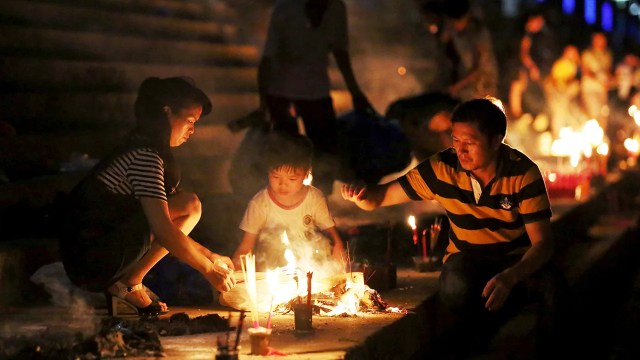
This report aims to explain the challenges of measuring religion and religious trends in China. These challenges include the shortcomings of available data, the awkward fit of categories used in other parts of the world, and the impact of culture and politics on religious activity in China.
Since Pew Research Center, like other non-Chinese organizations, is not allowed to conduct surveys in China, in this report we analyze surveys conducted by academic groups in China, including the Chinese General Social Survey (CGSS), the China Family Panel Studies (CFPS), the China Labor-force Dynamics Survey (CLDS) and the World Values Survey (WVS). We also analyze Chinese government data, which is primarily released by China’s State Council and the National Religious Affairs Administration (formerly known as the State Administration for Religious Affairs), and data from state-run religious associations, such as the China Christian Council and the Three-Self Patriotic Movement (CCC and TSPM) and the Islamic Association of China.
We explain how religion in China – and in East Asia more broadly – is distinct from religion elsewhere. Questions that measure Abrahamic forms of religion (Judaism, Christianity and Islam) are not sufficient to describe the breadth of religious beliefs and customs in East Asia. To capture the Chinese religious landscape as fully as possible, we consider a wide range of survey questions. For example, we present findings from questions about cultural beliefs and practices that also have spiritual or religious elements, such as gravesite visits and belief in fengshui (风水).
Throughout the report, we include Chinese terms because translations to English are often imprecise or incomplete. The Key terms section explains words and phrases that appear in the report’s Overview. A complete glossary can be found in Appendix A.
For context, we provide a summary of the recent history of the Chinese government’s policies toward religion. Refer to the Methodology for technical details, as well as a discussion of why surveys by Chinese universities may or may not be trustworthy. Read the section on current scholarship to understand other reasons why social scientists may shy away from research on religion in contemporary China.
This report is part of the Pew-Templeton Global Religious Futures project, a broader effort by Pew Research Center to measure religious change and assess its impact on societies around the world. The Pew Charitable Trusts and the John Templeton Foundation fund the Global Religious Futures project.
In Chinese, there’s no single, literal equivalent of the English word “religion.” Various terms are used for different kinds of beliefs and practices, reflecting nuances that get lost in translation. Chinese authorities show varying levels of tolerance for different categories of “religion,” even though the lines between them are often blurry. Appendix A has a complete glossary.
zongjiao (宗教) = religion: The most common Chinese translation of “religion,” zongjiao is usually understood as a form of organized religion. The Chinese government officially recognizes five zongjiao: Buddhism, Catholicism, Islam, Protestantism and Taoism. Affiliations, beliefs and practices closely associated with these religions are typically described as zongjiao. Confucianism, as well as folk beliefs and practices, are not typically considered zongjiao.
xisu (习俗) = traditional custom: Many popular rituals, such as Confucius veneration and temple festivals where folk deities – e.g., the goddess of the sea/Mazu (妈祖) and other local deities – are worshipped are characterized as xisu rather than zongjiao. Similarly, it is often considered a custom to venerate ancestors’ spirts, observe the (Hungry) Ghost Festival in Lunar July, and make offerings and pray to the god of wealth or burn incense and make wishes at a temple during Chinese New Year. The government often tolerates and even encourages these practices because they are considered Chinese cultural traditions, even though they are centered on spirits or deities.
mixin (迷信) = superstition: Most traditional Chinese religious activities outside zongjiao and xisu are categorized as mixin and officially banned. For instance, Chinese law forbids sorcery and witchcraft, which the government associates with fraud and other crimes. Practices it deems benign – such as fortune telling and fengshui (风水) – are tolerated. The line between custom and superstition is fuzzy. For example, some Chinese people consider fortune telling and fengshui to be customs, not superstitions. And while rituals such as burning “spirit money” and offering sacrifices of food and drink at ancestors’ gravesites are generally considered customs, they may be viewed as slipping into superstition when the ritual involves setting off firecrackers at the gravesite to ward off evil spirts or burning paper models of houses or cars.
xiejiao (邪教) = evil cults: Since 1999, the government has intensified crackdowns on groups it labels as xiejiao, including Falun Gong (法轮功), the Children of God, the Unification Church, and the World Elijah Gospel Mission Society.
xinyang, xin, xiangxin= belief/believe: Chinese surveys use these words to ask about belief. Each has slightly different meanings. In this report, all three are translated as “belief” or “believe,” but we note the corresponding Chinese term when appropriate.
xinyang (信仰) = firm belief in or commitment to a theory, thought or philosophy. Commonly used to indicate formal commitment or serious conviction.
xin (信) = trust/have no doubts in or worship/venerate. Common usage includes “xin jiao,” meaning to “believe in a religion.”
xiangxin (相信) = trust/have no doubts in. Typically implies weaker commitment than xin. Does not connote worship or veneration.
By virtue of its huge population, China is important to any effort to assess global religious trends. But determining how many people in China are religious today, and whether their religious identities, beliefs and practices have changed over the past decade, is difficult for many reasons. The challenges facing independent researchers include not just the Chinese government’s tight control of information and the Communist Party’s skepticism toward religion, but also linguistic and conceptual differences between religion in East Asia and other regions.
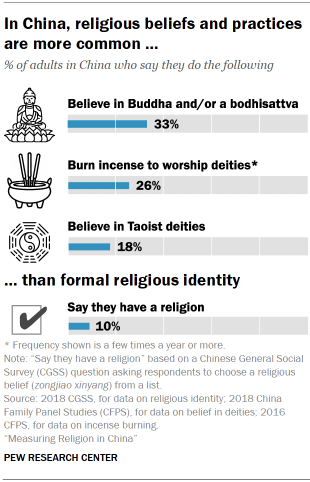
Because Pew Research Center has not conducted its own survey about religion in China, the Center’s demographers combed through data from various other sources – primarily surveys run by Chinese universities – to discern recent trends.
Depending on the source used, estimates of the share of Chinese people who can be described as religious in some way – because they identify with a religion, hold religious beliefs or engage in practices that have a spiritual or religious component – range from less than 10% to more than 50%.
For example, only 10% of Chinese adults identified with any religious group in the 2018 Chinese General Social Survey (CGSS).1 The Chinese language wording of this question – “What is your religious (zongjiao 宗教) belief (xinyang 信仰)?” – is understood in China to measure formal commitment to an organized religion or value system. Similarly, just 13% of Chinese adults say religion (zongjiao) is “very important” or “rather important” in their lives, according to the 2018 World Values Survey. Although these measures have fluctuated over time, none have clearly risen over the last 10 to 15 years.
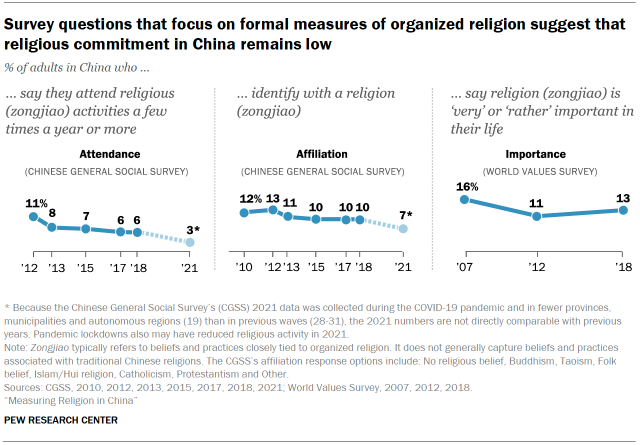
On the other hand, surveys indicate that religion plays a much bigger role in China when the definition is widened to include survey questions on spirituality, customs and superstitions.
For example, 33% of Chinese adults say they believe in Buddha and/or a bodhisattva, according to the 2018 China Family Panel Studies (CFPS) survey.2 The 2016 CFPS shows that 26% of Chinese adults burn incense at least a few times a year – a practice that, in China, typically involves making wishes to Buddha, a bodhisattva or other deities and often indicates hope in divine intervention.3 However, just 4% of Chinese adults claim Buddhism as their religious belief (zongjiao xinyang), according to the 2018 CGSS.
What ‘religion’ means in China
The discrepancy is partly due to linguistics: The closest translation of the English word “religion” in Chinese is zongjiao, a term Chinese scholars adopted in the early 20th century when they were working with Western texts and needed to translate “religion.” To this day, zongjiao – like the terms shūkyō in Japanese and jonggyo in Korean – refers primarily to organized forms of religion, particularly those with professional clergy and institutional or governmental oversight. Zongjiao does not typically refer to diffuse religious beliefs and practices, which many Chinese people consider to be matters of custom (xisu 习俗) or superstition (mixin 迷信) instead. (For more explanation of Chinese terms used in this Overview, refer to the Key terms section.)
Moreover, many Chinese people’s understanding of zongjiao may be influenced by the government’s view that religion reflects a backward mindset incompatible with socialism. In state media, for example, the term zongjiao is used alongside superstition to indicate corruption and wavering loyalty to the Chinese Communist Party.
But there is another reason why it is hard to pin down the number of people in China who are religious. It is a conceptual problem: Western definitions of religion and measures of religious participation – such as attendance at congregational worship services – fit the monotheistic religions of Christianity, Islam and Judaism but are less suited to traditional beliefs and practices in East Asia.
Since 1981, a global network of scholars at major universities has conducted the World Values Survey (WVS) in many countries, including China. In recent years, these surveys have included two questions about the importance of religion. One asks how important religion is in the lives of the survey respondents. The other asks how important it is to teach religion to children.
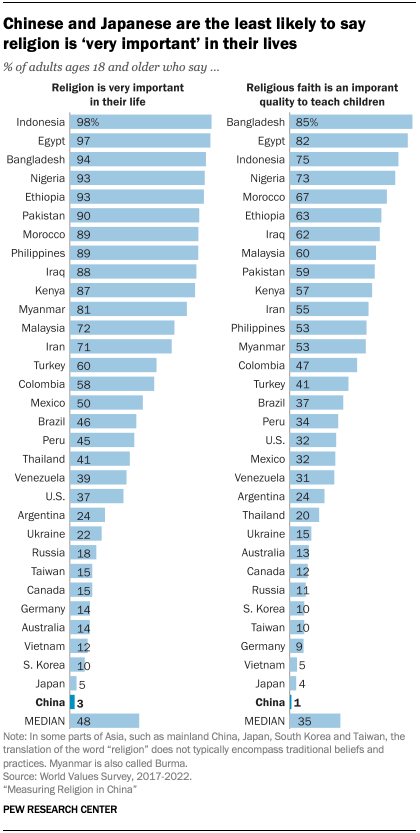
Across 32 places with populations of 20 million or more, the WVS finds a median of 48% of adults say religion is “very” important in their lives. No public has a smaller share of adults who say religion is very important than mainland China (3%), although other places in East Asia also rank low.
In Japan, just 5% of WVS respondents say religion is very important to them. Somewhat larger numbers in South Korea (10%) and Taiwan (15%) say the same.
East Asian publics also tend not to assign high importance to teaching religion to children. When asked to choose up to five qualities out of a list of 11 that are important to teach children, Chinese (1%) and Japanese (4%) adults are the least likely to choose religious faith. By comparison, across all 32 places, a median of 35% of adults say religious faith is one of the five most important qualities to impart to children.
However, scholars caution that these questions about the importance of religion may not be directly comparable across countries for linguistic, cultural and political reasons. In China and some other parts of East Asia, including Japan and South Korea, the term “religion” is understood primarily to mean formal, institutionalized religions.
Specifically, the Chinese word for religion in the WVS is zongjiao (宗教), which connotes five officially sanctioned religious traditions and does not necessarily capture the full range of Chinese customs and superstitions that might be considered religious or spiritual. In the Chinese version of the WVS question about qualities to impart to children, religion is phrased as qiancheng de zongjiao xinyang (虔诚的宗教信仰), which means “devout religious belief.”
In China, as well as in neighboring countries such as Japan and South Korea, there are many beliefs (such as in spirits) and practices (such as visiting shrines and making offerings to ancestors) that might be considered religious, broadly speaking. But there is little emphasis on membership in congregations or denominations, except among Christians and Muslims in these countries.
In East Asia, the boundaries between philosophical, cultural and religious traditions – such as Buddhism, Confucianism, Shintoism, Taoism and folk religions with local deities and regional festivals – are often unclear. People may practice elements of multiple traditions without knowing or caring about the boundaries between those traditions, and often without considering themselves to have any formal religion.4
Government restrictions on religion
Another challenge in measuring religion in China is that some affiliations, beliefs and practices are less officially acceptable than others – and thus, presumably, less comfortable for Chinese people to disclose in surveys.
Although the government formally recognizes five religions – Buddhism, Catholicism, Islam, Protestantism and Taoism – it closely monitors their houses of worship, clergy appointments and funding. Many activities that could help to maintain or expand these five zongjiao groups are banned, including proselytizing and organized religious education for children, such as Sunday schools or religious summer camps.
Enforcement has varied over time and by province, but since President Xi Jinping came to power in 2012, local officials have been less likely to overlook such activities. Religions that are not officially recognized, including those practiced mainly by ethnic minorities or foreigners, also are subject to a host of controls. Some groups, such as Falun Gong (法轮功), are completely banned.
(For more detail, read the section on how Chinese government policies toward religion have changed in recent decades.)
In addition, some zongjiao groups, particularly Muslims, face harsh treatment. The U.S. government estimates that Chinese authorities have detained more than 1 million Chinese Muslims, primarily Uyghurs, in “specially built internment camps.” The U.S. State Department has described abuses against Muslims in the Xinjiang Uyghur Autonomous Region as crimes against humanity and genocide. The United Nations Office of the High Commissioner for Human Rights has said the detention of predominantly Muslim groups and deprivation of their fundamental rights “may constitute international crimes, in particular crimes against humanity,” though the UN report avoids the controversial term “genocide.” For its part, the Chinese government has denied all allegations of genocide, torture, forced organ harvesting and sterilizations involving Muslims. Chinese authorities describe their treatment of Muslims as education and counter-terrorism efforts.
Christian groups also have accused China of religious persecution. For example, the government has arrested “underground” Catholic bishops and priests who are not affiliated with the official Chinese Catholic Patriotic Association, as well as Protestants who attend unauthorized places of worship also known as “house churches” (jiating jiaohui 家庭教会). Some Christians reportedly have been held in internment camps.
Because of these policies toward Muslims, Christians and other religious groups, China consistently ranks among the countries with the highest levels of government restrictions on religion, according to Pew Research Center’s annual reports on the topic.
For all the linguistic, cultural and political reasons described above, many Chinese people may be reluctant to associate themselves with religion (zongjiao) or to consider themselves to have a religious belief (zongjiao xinyang). Some zongjiao adherents may choose not to reveal this identity in surveys. (For more discussion of this issue, read “Can Chinese survey data be trusted?”)
Because of political sensitivity, studying religion in China also can be a minefield for scholars.
Challenges facing scholars of religion in China
Scholarly interest in the scientific study of religion in contemporary China seemed to be rising at the beginning of this century. In 2004, Purdue University sociologist Fenggang Yang organized the first annual Conference of the Social Scientific Study of Religion in China and a related training program. The conference was held each year until 2020. Hundreds of Chinese scholars attended for training on social scientific approaches to religion, opportunities to present research, and publishing advice. Training programs emerged in the United States for scholars from China and non-Chinese scholars studying religion in China, especially at the Center on Religion and Chinese Society at Purdue University, which later evolved into the Center on Religion and the Global East. New journals and edited volumes emerged to publish the results of this scholarly activity.
However, in recent years, studying modern religion in China has become more problematic. While some scholars continue to research the current state of religion in China, others have abandoned the field due to Chinese government policies that discourage the study of sensitive topics. Scholars who continue to focus on religion do so with increased caution about the scope of their research and how they present their findings. Such trepidation is not limited to scholars living in China, nor is it exclusive to those studying religion. A 2018 survey of more than 500 scholars outside mainland China who study Chinese society, conducted by political scientists at the University of Missouri and Princeton University, found that the Chinese government monitors research activity and sometimes retaliates against researchers.
About 9% of the survey’s respondents said they had been “invited to tea” to discuss their research with Chinese authorities. Access to archives was denied to roughly a quarter of those who asked for it. In addition, 5% reported difficulties getting travel visas, and about 2% were formally banned from visiting China. Scholars researching Xinjiang and Muslims were among those most likely to report visa complications and interviews with authorities.
In their analysis of this survey data, researchers Sheena Chestnut Greitens and Rory Truex conclude that the Chinese government creates ambiguity to intimidate scholars. Two-thirds of respondents said their research was sensitive, and some changed a project’s focus or abandoned a project altogether because of its sensitivity. However, most did not report any direct intervention from a government official. Respondents were slightly more likely to say that a government official had issued a warning to them through a colleague than to say an official had approached them directly.
Another factor limiting knowledge about the state of religion in China is restrictions on survey research and ambiguity about what may be permissible in surveys. In recent years, it has become increasingly difficult and, in some cases, impossible for foreign organizations to partner with Chinese institutions to conduct surveys in China. Furthermore, the staff of Chinese survey organizations may be uncertain which religion questions will elicit pushback from the government, and they may be highly cautious when considering whether to include religion measures in surveys of general attitudes and behaviors.
To our knowledge, the only surveys still collecting national data on religion in China are academic surveys, such as the Chinese General Social Survey and the China Family Panel Studies, which are supported directly or indirectly by Chinese government funding. For many years, Pew Research Center has been interested in collaborating on a survey of religion and spirituality in China. However, after investigating the possibility of doing so with various partners in China, we concluded that, given government restrictions, we could not carry out a survey dedicated to religion at this time.
Cultural traditions with spiritual underpinnings
In addition to the formal zongjiao measures and explicitly spiritual ones (belief in Buddha, burning incense) previously discussed, this report also analyzes several widely practiced rituals and customs that are considered cultural but may have religious or spiritual dimensions.
These traditions are observed by many Chinese people with and without a zongjiao affiliation. Chinese surveys have not asked respondents whether they perceive spiritual significance in these beliefs and practices, and the available data does not tie these activities to specific religions.
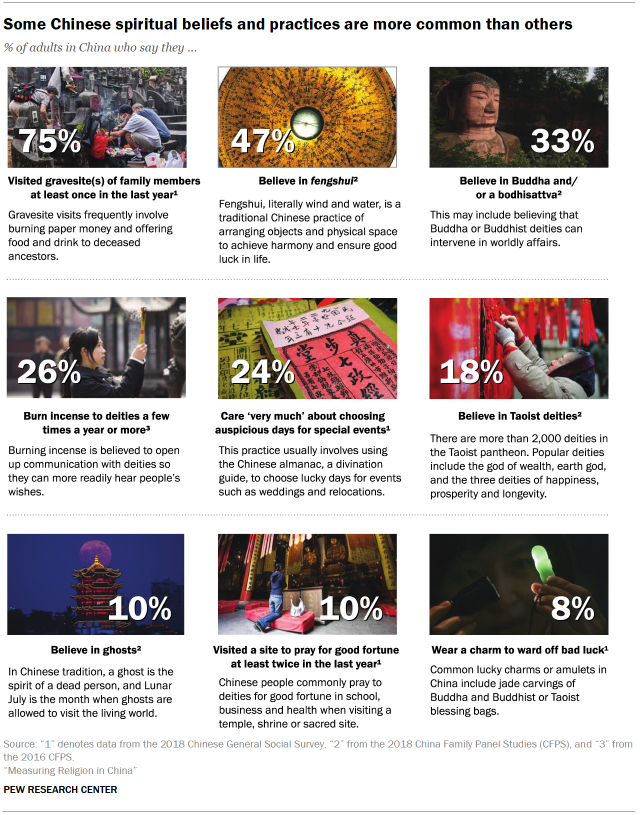
Gravesite visits
Three-quarters of Chinese adults visited a family member’s gravesite at least once in the last year, according to the 2018 CGSS. Visiting gravesites, especially on the Qingming Festival (Qingming Jie 清明节), or Tomb Sweeping Day, is part of the Confucian tradition of ancestor veneration (jizu 祭祖 or jisi zuxian 祭祀祖先). It commonly involves rituals with religious underpinnings, such as burning incense and “spirit money” or joss paper, making offerings of food and drink, and making wishes to ancestors.5
However, not all Chinese people engage in these rituals when visiting gravesites. For instance, some Chinese Christians may observe Tomb Sweeping Day to honor their parents or loved ones, yet intentionally distance themselves from ancestor worship by refraining from making wishes, burning “spirit money” or leaving offerings.
Fengshui
Nearly half of Chinese adults (47%) believe in fengshui (风水), according to the 2018 CFPS. Fengshui is a traditional Chinese practice of arranging objects and physical space to promote harmony between humans and the environment. Although people who practice fengshui may not think of it as a religious concept, it has roots in Taoism and sometimes involves belief in divine intervention.
Related practices include selecting auspicious days for important occasions and consulting fengshui masters to ward off bad luck.
Auspicious days
Six-in-ten Chinese adults (62%) say they care either “somewhat” or “very much” whether special occasions take place on an auspicious day or an inauspicious day, according to the 2018 CGSS. Choosing an auspicious day usually involves consulting the Chinese almanac or a fengshui expert. About a quarter of adults (24%) say they care very much about selecting auspicious days for special occasions, which can include weddings, funerals or moving to a new home.
Good fortune
Other traditional customs are less common. For instance, 24% of Chinese adults say they visited a site – typically a temple or shrine – to pray for wealth or good fortune in school, business or other matters in the past year, according to the 2018 CGSS. This includes 10% who did so twice or more in the past year. And 8% of Chinese adults say they carry a lucky charm or amulet to bring them good fortune or keep them safe from harm.
Mixing of beliefs
Many Chinese people engage in beliefs and rituals from multiple religious traditions. Chinese surveys do not ask respondents to state how often they do this, but a Pew Research Center analysis of data from the 2018 China Family Panel Studies (CFPS) indicates that combinations are quite common.
For example, about 40% of Chinese adults say they believe in at least one of the following: Buddha and/or a bodhisattva; Taoist deities; ghosts; and other gods or religious figures, such as Jesus Christ and Allah. And 20% believe in more than one of these religious concepts or deities. When fengshui (风水), a practice with Taoist underpinnings, is included, the share of Chinese adults who believe in both fengshui and at least one of these other ideas reaches 28%. The CFPS survey asks respondents whether they believe in each of the deities and religious concepts in a list. The Chinese term for “belief” (xiangxin 相信) used in this question does not necessarily connote religious faith. Refer to the Key terms section for more detail.
Some Chinese people who believe in figures associated with monotheistic religions, such as Allah and Jesus, also believe in traditional Chinese deities or supernatural forces. For example, about 7% of Chinese adults say they believe in Jesus Christ and/or Tianzhu (天主), a word used by Chinese Catholics for God. But only 2% hold such beliefs while rejecting all other deities and supernatural forces.
These are among the key findings of a Pew Research Center analysis of data on religion in China, part of the Pew-Templeton Global Religious Futures project, which seeks to understand global religious change and its impact on societies.
The remainder of this report includes:
- A chapter on signs of religious change in China
- Chapters on the major religious groups in China: Confucianism, Taoism and Chinese folk religions, Buddhism, Christianity, Islam, non-religion
- A brief history of Chinese government policy toward religion
For a discussion of how the data in this report compares with estimates published in earlier Center reports, refer to the Methodology.




